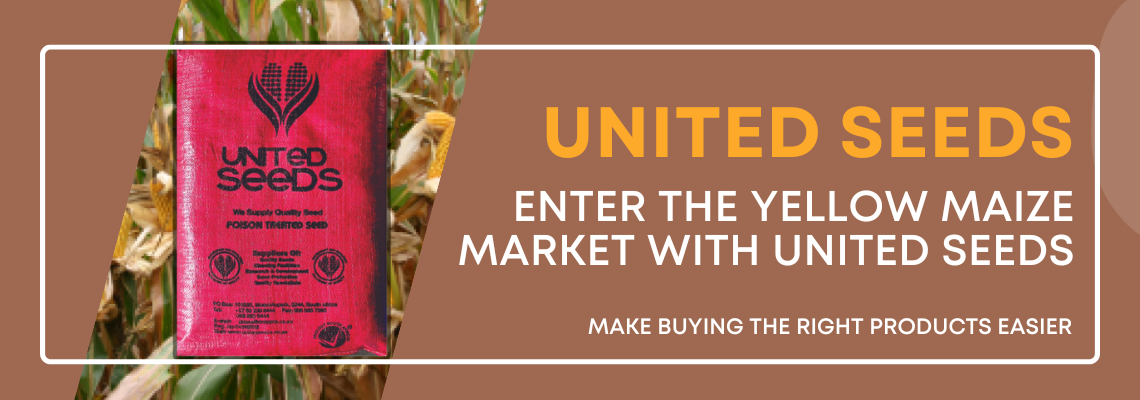Yellow Maize Crops with United Seeds | Product Education | AgBlogs

Are you deliberating which crops to plant in South Africa?
Yellow Maize is a staple crop and valuable commodity in this region. When it
comes to maize cultivation, using quality seeds are essential to ensure a high
percentage of germination, as well as hardy, healthy plants. United Seeds, a
renowned seed provider in South Africa, offers a range of yellow maize seeds
that can help you achieve success in your farming venture. In this article, we
will explore the benefits of planting yellow maize, essential steps to get you
started and diseases and pests that may crop up and hamper your success.
What is Yellow maize?
Yellow maize, also known as yellow corn, is a variety of
maize (Zea mays) characterised by its bright yellow kernels. In South Africa,
this maize is widely cultivated for its uses as staple food, animal feed,
agricultural, and industrial uses.
In what regions of South Africa can I grow yellow maize?
Yellow corn is grown throughout the country and is very
popular in the Free State, Mpumalanga, North West, Gauteng and parts of KwaZulu
Natal as these regions are in a summer rainfall region and the soil conditions
are favourable. The best way to ensure that you have a high-quality, high-yield
crop is to make sure you choose the correct variety that will adapt to the
conditions on your farm.
How do I choose which variation of yellow corn to plant?
United Seeds has a reputation for providing high-quality,
genetically superior maize seeds. One prime example of their plant offering is
the US9610
hybrid yellow maize. They have made absolutely sure that their seeds lead
to healthy plants that have a great recovery after unfavourable climate
conditions such as drought and heat. This is absolutely important to take into
consideration as we are entering an El Nino cycle meaning that there is a higher
chance of drought and heat waves expected in South Africa.
This corn variation has been extensively tested on the
market for 11 years and has a flowering time of 60-75 days. This maize variety
is ready for silage harvesting in a hundred days and reaches physiological
maturity in one hundred and twenty-five to one hundred and thirty days. The
plant height averages from two to two and a half meters and produces about 2
cobs per plant.
How many plants can you plant per hectare?
In dryland conditions where your field receives about four
hundred and fifty to seven hundred and fifty millimetres of rain per season,
you can work on about eighteen thousand to thirty thousand plants per hectare.
In high rainfall regions that receive about seven hundred
and fifty to on thousand two hundred millimetres per season you can work on
around thirty thousand to forty-five thousand plants per hectare.
On irrigated land where the rainfall is more than one
thousand two hundred millimetres, you can plant up to fifty-five thousand
plants and you can plant up to seventy thousand plants in a silage irrigated
hectare.
Diseases that may affect your yellow maize crop
This yellow corn variety has a great disease tolerance
against white a brown rust which are common diseases found on yellow corn. It
also has a good tolerance against Grey Leaf Spot, Fusarium, Diplodia, and Northern
leaf blight and a medium tolerance against Streak Virus.
How to get started – planting your first yellow maize crop.
The number one tip is to select the correct seed variety.
Choose the yellow maize variety that suits your local climate and soil
conditions from United Seeds on the AgMarket online platform.
Prepare your soil by ensuring the soil is well-drained, has
adequate nutrients and is free from weeds. Propper soil preparation is
essential for a successful crop. You can test your soil for the moisture
content and available nutrients. A good practice is to mulch your fields with
organic materials to lessen the amount of weeds growing through, thus giving
your crop a better chance of growing. Mulching can also assist with keeping
your soil moisture in dryer conditions.
Maize is typically planted in rows to facilitate the proper
spacing and easier maintenance, as well as ease of access when harvesting. You
will need to follow the recommended planting depth and spacing for your
selected maize variety. This is absolutely important to ensure that the seeds
have the best possible chance of germination.
Once your plants are growing, you need to scout through the
field to make sure that you catch any diseases or pests before they become a
problem.
Consult with agricultural experts to create a tailored
fertilization plan to add the right type and amount of fertilisers at different
stages of the growth of your plants.
When to harvest and store your yellow corn.
You will be harvesting your yellow maize approximately one
hundred days after planting. You should only harvest your grain when moisture
levels are low enough and the crop is fully matured. The kernel of the corn
should have a moisture level of below 14%. The reason for this is that maize
that has a higher moisture content when stored can cause mycotoxins, which have
serious effects on human and animal health. It is imperative to make sure your
grain harvest and transport machinery is clean, dry and free of insects, soil
and fungal growth.
Storage of your grain is also a very important aspect as you
can either sell your product immediately or store it until the pricing is more
favourable. The storage area should be dry and well-ventilated. Don’t pile the
harvest in large heaps and go through the product to remove any debris or
damaged corn.
Grading yellow maize for sale is essential to determine its
quality and value in the market. There are several factors in the grade,
including proper cultivation, harvesting and post-harvest handling. The grading
process typically considers aspects such as moisture content, kernel quality
and freedom from contaminants.
Your maize should be pure and uniform in colour with minimal
variation in kernel size and shape.
You can take your grain to your closest silo for moisture
testing as well to ensure you sell your harvest at the correct moisture level.
Yellow maize is a crucial crop in South Africa, serving as a
staple food and livestock feed. The versatility and importance of yellow maize
make it a key component of South Africa’s agricultural and economic landscape.
Planting yellow maize from United Seeds is a strategic move for entering the
agricultural market. With the right seeds, proper management practices, and
vigilance against pests and diseases, you can maximize your yield and enjoy a
profitable harvest.
Start your journey into the South African maize market with
the confidence that United
Seed’s quality seeds offer – now more easily available for sale at the AgMarket online
marketplace. They also have a range of other maize seeds available, as well
as soybean seeds. Get your seeds delivered straight to your farm.

